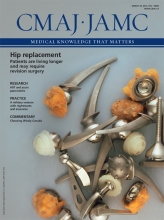A 7-year-old girl, who presented for an unrelated issue, had a 1-year history of an “itch” on the dorsal portion of both thumbs that led to frequent scratching and rubbing of the nail folds. The patient’s mother reported observing her daughter pulling out her hair three months earlier and that her daughter was particularly anxious. Physical examination revealed median depressions in both thumbnails with superimposed parallel, transverse ridging (Figure 1). There was no evidence of periungal dermatitis or chronic paronychia. Based on the results of the physical examination, habit-tic deformity was diagnosed. We suggested temporary occlusion of the nail folds with tape, but the patient’s mother preferred an expectant approach. We reassured her that the behaviour would likely resolve with time.
Central depression and transverse, parallel ridging of both thumbnails (habit-tic deformity) in a 7-year-old girl.
Habit-tic deformity is a form of nail dystrophy caused by habitual external trauma to the nail matrix.1 Although any nail can be affected, the thumbnails are often primary targets. Most patients report manipulating the proximal nail fold or periungual area with an adjacent fingernail, often in an unconscious manner. Characteristic changes to the nail include central depression and transverse, parallel ridging, both of which run from the nail fold to the distal edge of the nail. In severe cases, the cuticles may disappear, and the lunulae may hypertrophy.
Habit-tic deformity lacks the nail-thickening and onycholysis of fungal infections of the nail. The principal differential diagnosis is median canaliform dystrophy, a more rare condition that manifests as a midline splitting of the nail with oblique ridging, giving a fir-tree–like appearance to the surface of the nail.1 In median canaliform dystrophy, the cuticle may retain a normal appearance.
Habit-tic deformity responds well to the cessation of the external trauma. Effective interventions include physical barriers to picking such as tape or instant glue applied to the nail folds.2 Antifungal preparations are not effective. Because habit-tic deformity is related to obsessive–compulsive behaviours, trials of serotonin reuptake inhibitors may be used in refractory cases.3 Patients should be educated about cognitive behavioural strategies for anxiety management. This was particularly relevant in our patient’s case.
Clinical images are chosen because they are particularly intriguing, classic or dramatic. Submissions of clear, appropriately labelled high-resolution images must be accompanied by a figure caption and the patient’s written consent for publication. A brief explanation (250 words maximum) of the educational significance of the images with minimal references is required.
Footnotes
-
Competing interests: None declared.
-
This article has been peer reviewed.












